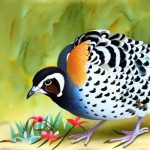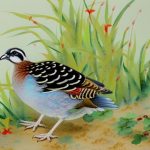Chinese Painted Quail, also known as King Quail or Button Quail, are small, ground-dwelling birds that are native to Southeast Asia and Australia. They are popular among bird enthusiasts for their colorful plumage and charming personalities. Chinese Painted Quail are known for their small size, with adults typically measuring around 4-5 inches in length. They come in a variety of colors, including brown, silver, blue, and white, and their feathers are often adorned with intricate patterns and markings.
These quail are social birds that thrive in small flocks, making them a delightful addition to any aviary or backyard setting. They are relatively easy to care for and can be kept as pets or for breeding purposes. Chinese Painted Quail are known for their gentle nature and can be quite tame with regular handling. They are also known for their distinctive call, which is a series of high-pitched chirps that can be quite endearing to their owners. Overall, Chinese Painted Quail are fascinating and beautiful birds that make a wonderful addition to any bird lover’s collection.
Table of Contents
- 1 Breeding Chinese Painted Quail
- 2 Housing and Environment for Chinese Painted Quail
- 3 Diet and Nutrition for Chinese Painted Quail
- 4 Health and Common Diseases of Chinese Painted Quail
- 5 Handling and Taming Chinese Painted Quail
- 6 Conclusion and Additional Resources for Chinese Painted Quail Care
- 7 FAQs
Key Takeaways
- Chinese Painted Quail, also known as King Quail, are small, colorful birds native to Asia and Australia, and are popular as pets due to their low maintenance and peaceful nature.
- Breeding Chinese Painted Quail requires a balanced ratio of males to females, proper nesting materials, and a quiet, stress-free environment to encourage successful reproduction.
- Housing and environment for Chinese Painted Quail should include a spacious cage with proper ventilation, substrate for nesting, and a quiet, draft-free location away from direct sunlight and extreme temperatures.
- A well-balanced diet for Chinese Painted Quail includes a mix of commercial game bird feed, fresh greens, and occasional treats like mealworms and fruits to ensure proper nutrition and health.
- Common health issues in Chinese Painted Quail include respiratory infections, parasites, and egg binding, and regular observation, proper hygiene, and access to a qualified avian veterinarian are essential for their well-being.
Breeding Chinese Painted Quail
Breeding Chinese Painted Quail can be a rewarding experience for bird enthusiasts. These birds reach sexual maturity at around 6-8 weeks of age, and breeding pairs can be easily established within a flock. It is important to provide a suitable nesting area for the quail, such as a small, secluded box filled with soft bedding material. The female will lay eggs every 1-2 days until she has a clutch of 8-12 eggs. The eggs will then be incubated for approximately 17 days before hatching.
Once the chicks have hatched, they will need to be provided with a warm and safe environment to grow and develop. It is important to provide them with a high-quality chick starter feed and access to clean water at all times. The chicks will grow rapidly and will reach maturity at around 6-8 weeks of age. Breeding Chinese Painted Quail can be a fascinating and educational experience, and it is important to ensure that the birds are provided with the proper care and attention throughout the breeding process.
Housing and Environment for Chinese Painted Quail
When it comes to housing Chinese Painted Quail, it is important to provide them with a suitable environment that meets their specific needs. A spacious aviary or enclosure with plenty of room for the quail to move around is ideal. The enclosure should also have a secure roof to protect the birds from predators and the elements. It is important to provide the quail with plenty of hiding spots and sheltered areas where they can retreat to if they feel threatened.
The flooring of the enclosure should be covered with a soft bedding material, such as straw or wood shavings, to provide the quail with a comfortable surface to walk on. It is also important to provide the quail with access to fresh air and natural sunlight, as this will help to keep them healthy and happy. Additionally, it is important to keep the enclosure clean and free from debris and waste, as this will help to prevent the spread of disease and ensure that the quail remain healthy.
Diet and Nutrition for Chinese Painted Quail
Proper diet and nutrition are essential for the health and well-being of Chinese Painted Quail. These birds are omnivorous and require a balanced diet that includes a variety of seeds, grains, insects, and fresh greens. A high-quality game bird feed can serve as the foundation of their diet, supplemented with fresh fruits and vegetables, such as lettuce, spinach, and carrots. It is also important to provide the quail with access to grit, which helps them to digest their food properly.
In addition to their regular diet, Chinese Painted Quail should also have access to clean water at all times. It is important to provide them with a shallow dish of water that is easy for them to access, as they may have difficulty drinking from deep water sources. It is also important to monitor their food intake and adjust their diet as needed based on their activity level and overall health. By providing the quail with a balanced and nutritious diet, you can help to ensure that they remain healthy and vibrant.
Health and Common Diseases of Chinese Painted Quail
Like all animals, Chinese Painted Quail are susceptible to a variety of health issues and diseases. It is important to monitor the quail closely for any signs of illness or distress, such as lethargy, loss of appetite, or changes in behavior. Common health issues that can affect Chinese Painted Quail include respiratory infections, parasites, and injuries from fighting or rough handling.
To help prevent health issues, it is important to provide the quail with a clean and sanitary environment, as well as access to fresh water and a balanced diet. Regular veterinary check-ups can also help to ensure that any potential health issues are identified and treated early on. By providing the quail with proper care and attention, you can help to ensure that they remain healthy and happy for years to come.
Handling and Taming Chinese Painted Quail

Chinese Painted Quail are known for their gentle nature and can be quite tame with regular handling. It is important to approach the quail calmly and gently when handling them, as sudden movements or loud noises can startle them. When handling the quail, it is important to support their body properly and avoid grabbing them by their wings or legs.
Regular handling can help to tame the quail and make them more comfortable around humans. It is important to spend time with the quail each day, talking to them softly and offering them treats to help build trust. Over time, the quail will become more comfortable with human interaction and may even seek out attention from their owners. By taking the time to handle and tame the quail, you can develop a strong bond with these charming birds.
Conclusion and Additional Resources for Chinese Painted Quail Care
In conclusion, Chinese Painted Quail are fascinating birds that make wonderful pets or additions to an aviary. With proper care and attention, these birds can thrive in a variety of environments and provide endless enjoyment for their owners. By providing them with a suitable housing environment, a balanced diet, regular veterinary care, and plenty of love and attention, you can help ensure that your Chinese Painted Quail remain healthy and happy for years to come.
For additional resources on caring for Chinese Painted Quail, there are many books, websites, and forums dedicated to bird care that can provide valuable information and support for bird enthusiasts. Additionally, local bird clubs or breeders may offer workshops or events where you can learn more about caring for these delightful birds. With the right knowledge and resources at your disposal, you can provide your Chinese Painted Quail with the best possible care and create a fulfilling experience for both you and your feathered friends.
If you’re interested in learning more about the breeding and care of Chinese painted quail, you might also want to check out this informative article on poultrywizard.com about the importance of the right chicken coop door size here. Proper housing and space considerations are crucial for the well-being and breeding success of quail, so this article could provide valuable insights for creating a suitable environment for your quail.
FAQs
What is the Chinese Painted Quail?
The Chinese Painted Quail, also known as the Button Quail, is a small ground-dwelling bird native to Southeast Asia. They are popular as pets due to their small size and colorful plumage.
What do Chinese Painted Quail eat?
Chinese Painted Quail are omnivores and their diet consists of a variety of seeds, insects, and small invertebrates. They can be fed a commercial game bird or finch mix, supplemented with fresh greens and the occasional mealworms or crickets.
How do you breed Chinese Painted Quail?
Breeding Chinese Painted Quail requires a suitable breeding environment with proper nesting materials and a balanced diet. The male quail will court the female by performing a mating dance, and the female will lay eggs in a well-hidden nest. The eggs will hatch after about 17 days.
What is the care required for Chinese Painted Quail?
Chinese Painted Quail require a spacious cage with plenty of hiding spots and soft bedding. They need a balanced diet, access to clean water, and regular cleaning of their living space. They also require regular social interaction and mental stimulation.
Meet Walter, the feathered-friend fanatic of Florida! Nestled in the sunshine state, Walter struts through life with his feathered companions, clucking his way to happiness. With a coop that’s fancier than a five-star hotel, he’s the Don Juan of the chicken world. When he’s not teaching his hens to do the cha-cha, you’ll find him in a heated debate with his prized rooster, Sir Clucks-a-Lot. Walter’s poultry passion is no yolk; he’s the sunny-side-up guy you never knew you needed in your flock of friends!







